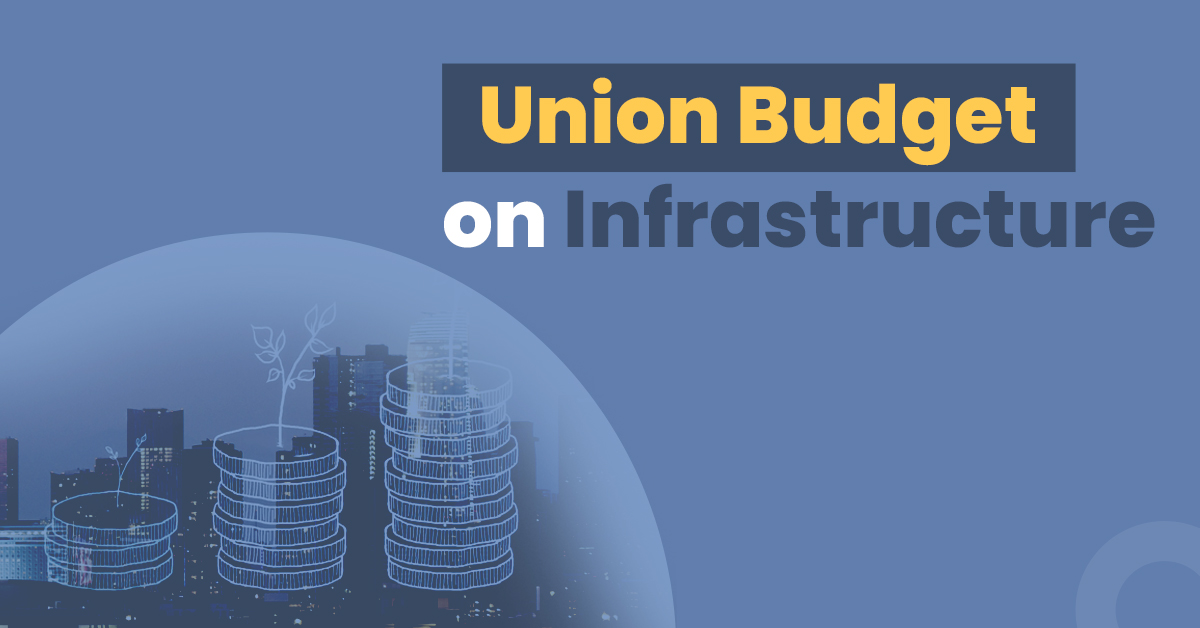Union Budget 2022-23 on Infrastructure


In the Union Budget 22-23, the Government of India has put its unprecedented focus on the infrastructure sector – physical and digital. Additionally, the Centre has also decided to provide ample support and funding for the states to take up the pace of development of infrastructure.
This focus and its objectives are threefold – hastening the currently dormant pace of employment creation, modernising and enhancing the country’s stock of infrastructure assets in areas ranging from energy and transportation to urban and digital infrastructure and revitalising the spirits of the economy to overcome pandemic-induced indolence.
Read on to know what allocations have been made for the infrastructure sector of India.
Overview of Infrastructure Sector in India
Infrastructure is one integral part of India’s economic growth. There have been some notable changes made in this industry which is gradually leading to development of world-class facilities in terms of roads, railways, ports, airports and many others.
As per the Department for Promotion of Industry and Internal Trade (DPIIT), Foreign Direct Investment (FDI) in the construction of townships, housing, built-up infrastructure, etc., and infrastructure activity sectors totalled USD 26.30 billion in December 2021. India is on the way to taking up major industrial and infrastructure projects worth USD 1.3 trillion.
The country-wide smart-city program has even hastened the rapid development of this industry. The Government of India has put even more emphasis on this industry as it is vital to India’s overall economic growth and development.
Key Announcements in Budget about Infrastructure Sector
Here are the key highlights of the Union Budget in relation to the infrastructure sector:
Roads & Highways
- Extension of the National Highways network by 25,000 km in 2022-23.
- Increment in number of expressways in 2022-23 to facilitate quicker movement of people and goods.
- PM Gati Shakti National Master Plan aims to cover the pillars for economic transformation, smooth multimodal connectivity and logistics efficiency.
- Contracts for 8 ropeway projects with a length of 60 km to be granted in 2022-23 under PPP mode as preferred as an ecologically sustainable alternative to conventional roads in challenging hilly areas.
Railways
- 2,000 km of railway network will be part of ‘Kavach’ to boost the initiative of ‘Atma Nirbhar Bharat’.
- ‘One Station-One Product’ concept for rail stations to be sanctioned to help indigenous businesses and supply chains.
- Design of metro systems, including civil structures, to be re-oriented and standardised as per Indian settings.
Logistics
- Contracts to be granted in 2022-23 for establishment of Multimodal Logistics Parks at 4 locations through PPP (Public Private Partnership) mode.
- Multimodal connectivity between urban transport and railway stations is to be enabled on priority.
- To optimally utilise the available infrastructure and improve the competitiveness of exports, it is suggested to replace the Special Economic Zones Act with new regulations that will allow the states to become partners in ‘Development of Enterprise and Service Hubs’.
Tax Policies
- No change in rates of corporate tax.
- Provisions of bonus and dividend stripping are also valid for units of InvITs/ REITs/ AIFs and securities.
- Justification of taxation of JVs taxed as AOPs.
- Surcharge reduced from 37% to 15%.
- Extra incentives in the form of exemptions arranged to incentivise procedures in IFSC, such as – advances from transfer of a ship leased by a unit set up in IFSC & royalty or interest income earned from a unit set up in an IFSC on account of the lease of a ship, in addition to the current exemption in relation to lease of an aircraft.
- Explanation on applicability of Social Welfare Surcharge on goods exempted from Basic Customs Duty suggested.
- Alteration in multiple duty rates in order to align “Make-in-India” and “Atma Nirbhar Bharat” policies.
- Key Custom Duty changes effective from 1 April 2022.
- Suggestion to ease off concessional rates in capital goods and project imports, and a moderate tariff of 7.5% will be applicable.
- Rearrangement of ITC provisions with newly introduced GSTR-2B.
- Suggested amendment concerning reversal of input credit along with interest where the supplier has not paid the tax.
- Transfer of amount available in electronic cash ledger under CGST or IGST of a ‘distinct person’ (GST registrations within the same PAN) is permissible.
- In the case of GST refunds, the applicable date for filing a refund for SEZ supplies is linked to the due date of monthly tax payment return (GSTR 3B).
Energy
- An additional allocation of Rs. 19,500 crore for Production Linked Incentive for manufacture of high-efficiency modules, with priority to fully integrated manufacturing units from poly-silicon to solar PV modules.
- Battery Swapping Policy as per interoperability standards to be articulated to overcome space restraints in urban areas to establish charging stations.
- Additional allocation of ₹19,500 crore for PLI scheme for domestic manufacture of high-efficiency modules in order to attain the target of 280 GW of installed solar capacity by 2030. Priority will be given to fully integrated manufacturing units of poly-silicon and solar PV modules.
- Sovereign Green Bonds to be issued for mustering resources for green infrastructure; proceeds to be arranged in public sector projects to reduce carbon intensity.
- Infrastructure status for Energy Storage Systems & Data Centres with dense charging infrastructure and grid-scale battery systems.
Implication of Budget Allocation on the Infrastructure Sector
Since 2019, a huge amount of infrastructure and industrial development has taken place. India aims to invest 1.4 trillion dollars in infrastructure between 2019 and 2023 to attain sustainable national development. For the period 2018 to 2030, the Government has suggested investing 750 billion dollars in railway infrastructure.
However, amidst all these developments, reforms of some policies are essential to create a sustainable private investment ecosystem. Some examples include:
- Expanding the classification of infrastructure investors for tax purposes.
- Growing domestic pension fund investments for infrastructure.
- Implementing standard templates & practices for choosing and contracting with private partners.
- Mustering long-term resources by higher pension allowance.
Final Words
Overall, the Union Budget 2022 seems to be growth-oriented, with a particular focus on infrastructure. These plans and schemes once implemented rightly, will have a multiplier effect on economic growth as well as employment opportunities.
Frequently Asked Questions
What is a Public Private Partnership (PPP)?
A public-private partnership (PPP) is an agreement between the Government or a Government entity and a private sector entity for the purpose of some public asset or services. The private entity is responsible for investments and is well aware of the risk of receiving performance-based payments.
What is IFSC?
IFSC stands for International Financial Services Centre. It provides to customers outside the jurisdiction of the national economy. It also takes care of the financial services and transactions carried out overseas by overseas financial institutions and branches/subsidiaries of Indian financial institutions to the Indian shores.
What is Form GSTR-3B?
Form GSTR-3B is a self-declaration that a registered GST taxpayer has to submit along with GSTR-1 and GSTR-2. It is a simplified return of GST liabilities for a particular tax period.




